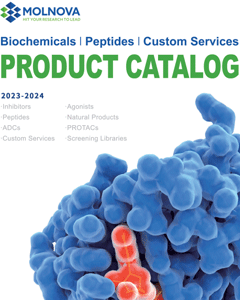
BAY-179
CAS No. 2764880-87-5
BAY-179( —— )
Catalog No. M37661 CAS No. 2764880-87-5
BAY-179 is a potent, selective, and species cross-reactive complex I inhibitor used for cancer research.
Purity : >98% (HPLC)
 COA
COA
 Datasheet
Datasheet
 HNMR
HNMR
 HPLC
HPLC
 MSDS
MSDS
 Handing Instructions
Handing Instructions
| Size | Price / USD | Stock | Quantity |
| 2MG | 46 | Get Quote |


|
| 5MG | 116 | Get Quote |


|
| 10MG | 183 | Get Quote |


|
| 25MG | 410 | Get Quote |


|
| 50MG | 638 | Get Quote |


|
| 100MG | 867 | Get Quote |


|
| 200MG | 1152 | Get Quote |


|
| 500MG | Get Quote | Get Quote |


|
| 1G | Get Quote | Get Quote |


|
Biological Information
-
Product NameBAY-179
-
NoteResearch use only, not for human use.
-
Brief DescriptionBAY-179 is a potent, selective, and species cross-reactive complex I inhibitor used for cancer research.
-
DescriptionBAY-179 is a potent, selective, and species cross-reactive complex I inhibitor (IC50=79 μM).
-
In Vitro——
-
In Vivo——
-
Synonyms——
-
PathwayOthers
-
TargetOther Targets
-
RecptorMitochondrial Metabolism
-
Research Area——
-
Indication——
Chemical Information
-
CAS Number2764880-87-5
-
Formula Weight415.51
-
Molecular FormulaC23H21N5OS
-
Purity>98% (HPLC)
-
SolubilityIn Vitro:?DMSO : 62.5 mg/mL (150.42 mM; Ultrasonic (<60°C)
-
SMILESC(N1CCC(C2=NC(C3=CC=4C(O3)=CC=CC4)=CS2)CC1)C=5NC=6C(N5)=NC=CC6
-
Chemical Name——
Shipping & Storage Information
-
Storage(-20℃)
-
ShippingWith Ice Pack
-
Stability≥ 2 years
Reference
1. Mowat J, et al. Identification of the Highly Active, Species Cross-Reactive Complex I Inhibitor BAY-179. ACS Med Chem Lett. 2022;13(3):348-357. Published 2022 Feb 18. ?
molnova catalog



related products
-
Spiroxamine
Spiroxamine is a tertiary amine fungicide and an inhibitor of δ14 reductase and δ8→δ7 isomerase. Spiroxamine inhibits the growth of N. parvum, B. dothidea, D. seriata, and L. theobromae isolates from grape vines.
-
CTPS1-IN-1
CTPS1-IN-1 is a cytidine-5′ triphosphate synthase 1 (CTPS1) inhibitor with potential antitumor activity and can be used to study autoimmune diseases.
-
[Ala1,?3,?11,?15]?-?...
[Ala1,3,11,15]-Endothelin (TFA) is a highly selective for endothelin A (ETA) and endothelin B (ETB) receptor.[Ala1,?3,?11,?15]?-?Endothelin is a selective ETB endothelin receptor agonist (IC50 values are 0.33 and 2200 nM for displacing [125I]-ET-1 from ETB and ETA receptors respectively).



 Cart
Cart
 sales@molnova.com
sales@molnova.com


